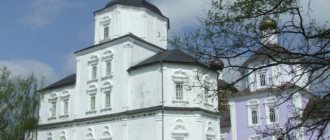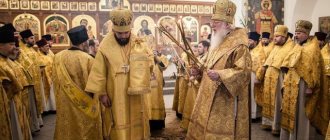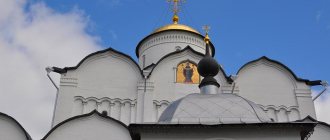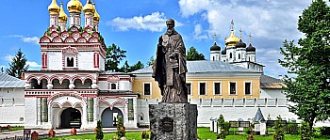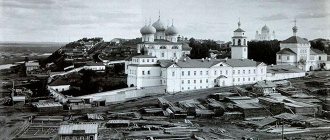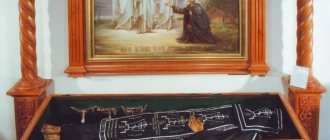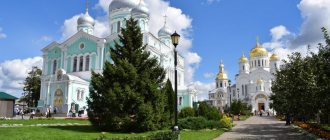The Holy Dormition Oryol Monastery is both an active religious site and a cultural attraction, since its territory is open to tourists who want to see the beauty of both the interior decoration and the services. The monastery consists of three small churches where you can venerate the Orthodox shrines kept here.
The temple was built at the end of the 17th century, but over its relatively short history it has gone through a rather difficult path. It suffered the massive closure of religious sites in the mid-20th century, and then, in 1980, the Assumption Church turned out to be an obstacle along the route of the Olympic torch. The temples that rise here today are updated and restored structures, which, however, does not reduce their cultural and historical significance for the city and the country.
© Max
Schedule of services of the Assumption Monastery in Orel for July 2021
History of the foundation of the monastery
The monastery was moved to a place called Kamenny Verkh, where since ancient times monks labored in caves excavated for the feat, the monastery was moved in 1673 after a fire in the Epiphany Monastery. And here the new Oryol Assumption Monastery was already founded.
- The townspeople were glad that a monastery had appeared in Orel itself, so already in 1688 they rebuilt the stone Assumption Church, and in 1700 a chapel was added in honor of the Nativity of St. John the Baptist. From that time on, the monastery began to be called Assumption.
Holy Dormition Monastery, Orel - In 1693, in the Assumption Monastery of Orel, a gate church was built in honor of the Apostles Peter and Paul to conduct services specifically for the laity, so as not to distract the monks with vain desires.
- The monastery was surrounded by a stone fence and acquired its finished appearance. Many citizens of Orel donated their funds for its improvement.
- With the beginning of the reforms of Peter I, including in the church sphere, the Holy Dormition Oryol Monastery lost its independence, since it was given in 1725 to the subordinate authority of the Kolomna Bishop's House.
- In connection with the reform of Catherine II, the Holy Dormition Monastery of the city of Orel was left with a third-class staff, and 806 rubles per year were allocated for its maintenance.
In 1818, the Assumption Monastery acquired the status of a bishop's house. A number of buildings are being erected here, including the house where the Oryol rulers lived, as well as the building of the spiritual consistory. The Holy Dormition Oryol Monastery becomes the center of the spiritual and administrative life of the diocese. In the period before the revolution, the Holy Trinity Church was built on its territory, as well as the Annunciation Church.
Orlovsky Holy Dormition Monastery Diocesan monasteries of the Russian Orthodox Church
At this place, schema-monks from the brethren of the Epiphany Monastery once lived in caves dug with their own hands, and in ancient times, even before the invasion of the impostor and the Poles, there was also a monastery here. The transfer of the monastery was accomplished with the blessing of Archbishop Nikita of Kolomna and Kashira under Abbot Euthymius, through whose labors the monastery was built.
The main church of the monastery, after which it is named, was the stone church of the Dormition of the Blessed Virgin Mary, built in 1688, with a chapel in the name of the Nativity of St. John the Baptist, added in 1700. To conduct services for the laity, in 1693 a stone gate church was also built in the name of the holy supreme apostles Peter and Paul, and in addition a stone chapel. A stone fence with two towers was built around the monastery. For his labors, Abbot Euthymius was elevated to the rank of archimandrite.
On the day of the founding of the Church of the Assumption, “as a gift and blessing to the newly built monastery”, from the elders of the Epiphany Monastery Theodosius and the perspicacious Anthony, a schema-monk with the brethren, an icon of the Assumption of the Blessed Virgin Mary of ancient Byzantine writing was brought during the procession. This icon, revered as miraculous, was the main shrine of the monastery.
During the Dormition Lent, an akathist service was performed before this icon, and on Wednesdays - with the participation of the bishop himself.
During the construction of the monastery, many pious citizens of the city made donations of money and property. Duma nobleman Nikita Ivanovich Akinfov, steward Yushkov and Apukhtin, as well as Major General F. M. Kamensky showed particular zeal here.
Initially, the monastery “fed the world,” but then it was also granted estates - the villages of Arkhangelskoye and Monastyrskoye, the village of Orlitsa and Podmonastyrskaya Slobodka. Contributions were also received “for the sake of the soul.”
Since 1725, the monastery was assigned to the Kolomna bishop's house, and a school was created in it to educate the children of the clergy, in which in 1727 there were 25 people. According to the decree of Emperor Peter I, the monastery took into its care former military and disabled people. In 1741 there were six of them, 21 monks and 14 novices. At that time, 482 peasant souls were assigned to the monastery.
According to the decree of Empress Catherine II in 1766, the monastery was designated as a third-class monastery. All of his estates were “assigned to the treasury,” and his annual allowance was determined to be 806 rubles, and the number of monastic brethren was determined to be 12 people. In addition to maintenance, contributions continued to be received into the monastery.
In 1779, a seminary was established in the monastery, in which 285 students studied in 1780, and in 1790 - already 382.
On April 26, 1818, in the Holy Dormition Oryol third-class men's monastery, by the highest approved decision of the Holy Governing Synod, the episcopal house of the Oryol and Sevsky archpastors was established. This happened under Bishop Jonah, the third bishop of Oryol and Sevsk. Tsar Alexander Pavlovich allocated one hundred thousand rubles for the construction of the bishop's house during his stay in Orel.
Work on the reconstruction of the monastery began in 1821 and was largely completed in 1824. A bishop's house with a house church, a consistory building and economic services were built.
In 1843-45, a stone church was built in the bishop's house - a tomb over the ashes of the family of the Oryol governor Arkady Vasilyevich Kochubey. The temple was consecrated in the name of the Life-Giving Trinity.
According to the inventory of 1854, a stone church in the name of the Annunciation of the Blessed Virgin Mary was also listed at the bishop's house.
In the period 1860-1879. In the bishop's house, the construction of the five-domed cathedral of the Oryol and Sevsk diocese - a temple in the name of the Holy Trinity - took place. The consecration of the temple was performed in the summer of 1879 by Bishop Juvenaly of Orlovsky and Sevsky.
Archbishop Paisiy (Samchuk) (+ 2008), bishops Nikodim (Bystritsky) (+1839), Polycarp (Radkevich) (+1867), Yuvenaly (Karyukov) (+1883), Irenaeus (Horde) (+1904), were buried in the monastery. Mitrofan (Athos).
The new history of the Assumption Monastery, after its closure by the Bolsheviks, begins in 1991, when the site of the altar of one of the destroyed monastery churches was consecrated. In 1992, the Trinity Church-burial vault (now a gymnasium church), which remained a parish church for several years, was returned to the diocese.
The first inhabitants of the monastery were the Oryol residents K.S. Golovkov and D.Yu. Kosenko. The first subsequently took monastic vows with the name Cornelius and became the first abbot of the reviving Assumption Monastery.
The buildings of the former Assumption Monastery are completely lost. Of the buildings of the bishop's house, only the two-domed Trinity Church-burial vault, built in 1843-1845, has survived. (architect N. Efimov) by order of the Oryol governor A.V. Kochubey as a funeral temple, where his mother, wife and two sons were buried (the graves are lost). In 1992, restoration work was carried out on the building, and on January 22, 1993, the restored church was consecrated by Bishop Paisius of Oryol and Bryansk.
Since 1990, construction of a new Assumption Church begins (according to a new project).
On April 20, 1992, by decision of the mayor of Orel A.G. Kislyakov, the territory of the former monastery was transferred to the Oryol-Bryansk diocese. Since 1996, monastic life has been resumed.
The monastery was reopened by decree of the Holy Synod of the Russian Orthodox Church on June 9, 1998. Hieromonk Korniliy (Golovkov) was appointed rector.
In 2002, a new church was built and consecrated in the name of the Dormition of the Blessed Virgin Mary. The author of the project is architect M. B. Skorobogatov.
In 2004, the construction of a chapel in honor of the Blessed Prince Alexander Nevsky was completed on the territory of the monastery. In 2006, the chapel was consecrated. Under the chapel there is an artesian well 148 meters deep. Here the water is blessed and offered to parishioners. A silver container is used to collect, store and sanctify water.
In 2008, the construction of a new five-domed cathedral was completed; on November 4, 2011, the Kazan Cathedral of the monastery was consecrated by His Eminence Archbishop Anthony of Oryol and Livensky.
Every day a full cycle of daily worship is performed in the monastery. Divine services are held in the single-altar Assumption Cathedral.
Current state
During the Soviet period, the Assumption Monastery in Orel was almost completely destroyed. Only the Trinity Church-tomb above the crypts of the Kochubey family has survived.
Holy Dormition Oryol Monastery at the beginning of the twentieth century
The monastery was transferred to the Oryol and Bryansk diocese in 1992, from which time its revival began.
- In 1998, a functioning monastery was reopened.
- In 2002, the newly built Assumption Church, the main church of the monastery, was consecrated.
- The Kazan five-domed Cathedral was consecrated in 2008.
Since 2013, the Annunciation Church has been under construction, the monastery itself is surrounded by a fence and, despite its previous desolation, is regaining its former complete perfection.
"Golden Age" of Oryol monks
A century later, in May 1788, the Oryol diocese was established by resolution of the Holy Synod. Over the next decades, its leadership steadily contributed to the development and improvement of the monastery operating on its territory. Thanks to this, by the end of the 19th century, the monastery in honor of the Dormition of the Blessed Virgin Mary was a very extensive complex, which included 5 existing churches, as well as a large number of various kinds of administrative and economic buildings.
On its territory there was an elementary school for children from low-income families, as well as an icon-painting and bookbinding workshop. By that time, the territory of the monastery cemetery had been landscaped and turned into a necropolis, where the prominent philanthropist and theatrical figure Count G.I. Chernyshev, as well as the hero of the war of 1812, Baron F.K. Korf, were buried among the honorary citizens.
During this most favorable period of its history, the brethren of the Holy Dormition Monastery (Orel), in addition to state subsidies, received income from the extensive fishing grounds they owned, as well as leased lands donated by wealthy pilgrims. They also had their own production workshops, in which they worked along with hired workers.
Temples and services
In the Holy Dormition Monastery in Orel there are now three churches in which services are held:
- Kazan Cathedral, built in the period 2005-2011;
- Trinity Church built in 1844-45, restored from ruins;
- Assumption Church, built in 1990-2005.
Kazan Cathedral of the Holy Dormition Monastery
Also on the territory of the monastery there is a chapel in honor of Blgv. Prince Alexander Nevsky. Divine services are held every day. The evening service begins at 17.00, liturgy at 7.40. There are two liturgies on Saturday and Sunday: early at 6.20, late at 8.40.
In a new place
Reasoning very sensibly that, while remaining in the same place, the monastery would burn more than once due to its proximity to careless Slobozhans, he decided to move it outside the fortress. After a short search, a site was chosen, located a mile from the city on the banks of the Oka. There in 1684 he founded a wooden church, which was then consecrated in honor of the Dormition of the Blessed Virgin Mary and gave the name to the Holy Dormition Monastery that has survived to this day in Orel. Its first rector was Hieromonk Euthymius himself, who by that time had been elevated to the rank of abbot.
Patronal holidays
The throne in the Trinity Church is a temporary holiday depending on Holy Easter. The Kazan Cathedral celebrates twice on July 21 and November 4.
Divine service at the Holy Dormition Monastery
In the Assumption Church on August 28 there is a special celebration, since it is on this day that the Dormition of the Mother of God is remembered.
Finally, in the chapel there are two dates commemorating St. blgv. book Alexander Nevsky on September 12 and December 6.
Vandals of the 20th century
Immediately after the October armed coup and the coming to power of the atheistic Bolshevik government, persecution of the church began. They also affected the Orthodox residents of the city of Orel. The Holy Dormition Monastery was closed, and its inhabitants were expelled from their habitable cells. Subsequently, many of them were repressed for promoting a religious ideology alien to the new government and joined the ranks of countless Russian new martyrs of the 20th century.
As for the monastery territory and the buildings located on it, over the next decades they were used in the most barbaric manner. Thus, the highly artistic marble tombstones that previously adorned the necropolis were destroyed in the mid-20s and used as building material for the reconstruction of the dam across the Oka River. Those that, for various reasons, were not suitable for the builders were simply thrown into the water.
A similar act of vandalism was committed against the former rector’s house, which was a striking example of early 19th century architecture. To equip the production premises of a local cloth factory, the building was rebuilt, stripped of its original appearance and turned into a rough, faceless structure. The remaining monastery buildings, including the five churches located on its territory, were also made available to various economic organizations. And over the following years they were mercilessly destroyed.
In the post-war years, a children's educational colony was created on the territory of the monastery, in which for three decades teenagers who had not reached adulthood, but managed to come into conflict with the law, were kept. Their presence also did not contribute to the preservation of what remained of the ruined monastery. As a result, by the beginning of the 80s, almost all the temples were destroyed.
Under the leadership of Bishop Nektarios
Much credit for organizing the spiritual and economic life of the revived monastery belongs to its vicar, Bishop of Liveno and Maloarkhangelsk Nektariy (Seleznev), who was appointed to this position in 2012. His photo is given in the article. On the initiative of the bishop, a marble plaque was installed on the territory of the monastery in memory of the native of Orel, the famous monarchist poet and active participant in the White Guard movement Sergei Bekhteev.
Many pilgrims are attracted by the holy spring, over which, by order of Bishop Nektary, a chapel was erected in honor of the Blessed Prince Alexander Nevsky. Its water, coming from an artesian well going to a depth of 150 meters, is stored in a special silver container and has healing properties.
Notes[ | ]
- Journals of the meeting of the Holy Synod of April 13, 2021 (unspecified)
. Moscow Patriarchate (04/13/2021). — “Magazine No. 22.” Access date: April 15, 2021. - Monastery in honor of the Dormition of the Blessed Virgin Mary (unspecified)
(inaccessible link). Retrieved January 31, 2011. Archived March 4, 2021. - ↑ 1 2 3 4 Nedelin V.M., Romashov V.M.
Architectural antiquities of the Oryol region (gone). - Book 2. - Eagle: Spring Waters, 2009. - ISBN 978-5-87295-207-7. - Proceedings of the Oryol Scientific Archival Commission. Vol. 3: Moving the Oryol episcopal see from Sevsk to the provincial city of Oryol / comp. G. Pyasetsky. — Eagle: type. Lip. Board, 1888. - P. 17.
- Livtsov V. A.
Oryol necropolis. — Orel: Publisher: IP Naumenko D.V., 2011. - Monastery Square has been restored in Oryol
- JOURNAL No. 119 of the meeting of the Holy Synod of August 30, 2019 (unspecified)
.
Photos
A more complete picture of the fate of the modern Church of the Archangel Michael from the moment of its foundation to the present day can be seen in the photographs presented below:
Abbots of the monastery
- Kornily (Golovkov) (June 9, 1998 - December 21, 1998)
- Seraphim (Zvyagin) (1999 - 2000)
- Avvakum (Kazurov) (2000 - June 10, 2005)
- Feodosius (Fatich) (June 10, 2005 - December 18, 2007)
- Efrem (Boenko) (December 18, 2007 - September 25, 2008) acting governor
- Nektary (Seleznev) (November 2011 - March 16, 2012) acting governor
- Kirill (Savvin) (2019) acting governor
Liquidation and children's colony[ | ]
After 1917, the bishop's house burned and was looted. In 1923 it was finally closed, and in the 1930s the Trinity Cathedral was blown up. The monastery cemetery suffered: in the 1920s, the tombstones were used to repair the Bannaya dam across the Oka River; in 1932, the remaining tombstones were thrown into the river[5].
After 1918, the complex of the former bishop's house, undergoing reconstruction, was used to house various institutions. From 1950 to 1980 there was a children's educational and labor colony here. The cemetery was destroyed in the 1970s. during the construction of a parking lot. By 1980, almost all the churches of the former monastery were gradually destroyed.
In 1980, to carry the Olympic flame through Orel, the unique Assumption Church of the 17th century, which was visible along the route of the torchbearers, was destroyed.


